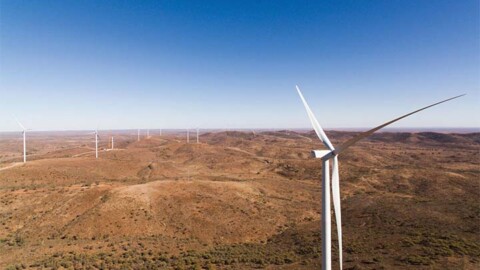Electrical wellheads submerged in floodwaters, power boxes overheating in 45-degree weather, maintaining ageing infrastructure, meeting rising energy demand – these are just some of the challenges Origin Energy’s Senior High Voltage Engineer Nick Bristow faces in his line of work.
Mr Bristow and his team are responsible for the safe and reliable operation of hundreds of critical high voltage assets for Australia Pacific LNG including seven main substations, 15 gas processing substations, a high voltage kiosk and almost 4,000km of electrical cable.
“There’s no such thing as a typical work week in this area of the business,” Mr Bristow said.
“The focus of our job is to make sure all high voltage equipment is operating safely, and responding to any issues so we can avoid outages.”
For Mr Bristow and the Origin team, this can be anything from investigating circuit breaker faults in the field, to transformer maintenance, or growing the field substations with new infrastructure.
“Our overall goal is to minimise the number of equipment failures that happen and make sure the network’s operating smoothly.”
Keeping the Australia Pacific LNG network live
Australia Pacific LNG is the largest producer of natural gas in eastern Australia. Through a network of high voltage transmission lines and power stations, which Mr Bristow and his team work to keep running, Australia Pacific LNG’s gas field facilities are powered by electricity from the Queensland electricity grid.
During the Australia Pacific LNG construction phase from 2013 to 2018, Mr Bristow was contracted to work as a commissioning electrical engineer to help bring the project’s Condabri Central Gas Processing Facility online. Origin was able to reduce the facility’s noise and air emissions, maximise gas production, and ensure reliability by powering gas facilities with power from the grid instead of produced gas.
“It was a very interesting and unique project to work on, and ultimately led me to working at Origin in my current position,” Mr Bristow said.
“Origin manages the upstream operation of Australia Pacific LNG, which is made up of a suite of relatively young assets like the network.
But some of the infrastructure has been operating for more than a decade now, so there is more effort needed these days to prevent unplanned outages.
“With this challenge in mind, we are exploring new technologies and methods to better mitigate and respond to electrical disruptions.
“One of these new technologies is a cable partial discharge monitoring system, which is designed to detect potential partial discharge failures and allow us to intervene before the event occurs.”
Cable joints are vital components in Origin’s transmission network and defects in cable joints can lead to a system fault. If a joint starts to fail, the cable partial discharge monitoring system detects the small electric pulse generated and then alerts Origin of the issue so it can identify its location and make plans to fix it.
Mr Bristow also said he and the team benefit from the planned turnarounds that Origin undertakes on assets to allow maintenance, investigations and repairs to help prioritise and schedule their own maintenance and repairs on high voltage equipment.
“Additionally, we have established a specialised team of high voltage coordinators within Origin to assist with high-risk high voltage work activities throughout Australia Pacific LNG.”

Origin Energy Senior High Voltage Engineer Nick Bristow and HV Technician Matthew Buonaccorsi inspect high voltage maintenance activities being undertaken as part of a planned turnaround at the Eurombah Creek Gas Project.
Putting safety first
Extreme weather conditions add yet another challenge Mr Bristow and his team have to prepare for, in terms of safety and reliability for high voltage work. Mr Bristow said this extreme weather, in particular flooding, is an environmental challenge that is always present in his line of work.
“The network has some high voltage assets in areas that have experienced flooding, but as we move forward and technology improves, we’re able to approach these challenges differently now than we used to.
“We now have what are called ‘sacrificial assets’ being used at well sites located in areas we are aware have flooded in the past.
This allows us to set up wells in these sites with the ability to abandon a voltage feeder – or mainline – in the event of flooding so we don’t have live services in that area.
“With these new controls in place we can go after gas in locations previously out of reach because of the risk of damage to the network.”
Built from experience
Although Mr Bristow has been at Origin for the past four years, he has worked as an electrical engineer for over a decade engaged on a variety of projects and in a range of different roles, including the Victorian Desalination Plant, the Newcrest Cadia Underground Gold Mine, and the Tallawarra gas-fired power plant in Wollongong.
“After graduating from RMIT University I was involved in commissioning the Tallawarra plant as part of my engineering work experience, which was a huge learning curve for me.
“One of the takeaways from that experience that has always stuck with me throughout my career was the focus and attention to safety on that project, with strict lockout tagout protection systems using lock boxes, permit boxes, or similar personal locking centralisation methods to keep everyone safe.
“At Origin, we’ve invested a lot of time and effort in building a strong safety culture working with high voltage electricity. We look at incidents in Origin and at our industry peers, then formalised those learnings into a safety standard guide to consult.
“In the high voltage space there is a lot to learn and improve, and with advancements like adding solar to the network, the future is looking interesting.
“I’m really proud of the work the team and I have been able to accomplish in this space across the Australia Pacific LNG network to date and look forward to meeting the challenges ahead.”

















